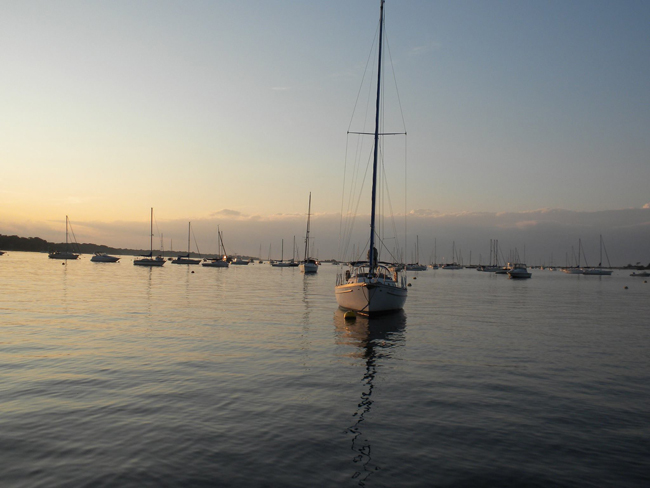Stony Brook, NY, April 21, 2014 - In late 2013, the Long Island Sound Study (LISS) announced that the most comprehensive review and synthesis of scientific research about the Long Island Sound in 35 years has become available in print and digital form.
Long Island Sound: Prospects for the Urban Sea was written by scientists, resource managers, and historians who gathered nearly 1,500 research papers to summarize what is known about the historic and recent trends of the ecological health of Long Island Sound (LIS).
Six technical chapters describe the Sound’s human history, geology, physical oceanography, geochemistry, pollutant history, biology and ecology. A seventh chapter details the cross-cutting issues and complex interrelationships between different environmental and socio-economic trends to help provide guidance to planners, environmental managers, and policy makers on how to manage coastal waters such as the Sound.
As cited in the book's preface, "While the book is largely targeted to a technical, scientific audience, it is our belief that science is too important to be left exclusively to scientists, planning too important to be left exclusively to planners, and environmental management too important to be left exclusively to managers. Successful ecosystem-based management of LIS will require that if the old walls between these fields must remain, they should at least have larger windows."
The idea for the book sprang from the Science and Technical Advisory Committee of the LISS whose members identified the need for a synthesis of new science on the Sound—concepts to update what was used to develop the Sound’s Comprehensive Conservation and Management Plan in the mid-nineties. The U.S. Environmental Protection Agency provided funding to write this multidisciplinary synthesis through cooperative agreements with the Connecticut and New York Sea Grant Programs.

Sunset in Port Jefferson Harbor, a Long Island North Shore waterway situated on Long Island Sound. Photo: Barbara A. Branca.
Among the new and enduring challenges addressed in the book’s technical chapters and synthesis chapter are climate change, coastal development and use conflicts, fisheries management goals, emerging contaminants, invasive species, and nutrient pollution.
“Synthesizing decades of research into one volume will be of enormous value for environmental managers and policy makers as they make critical decisions on protecting natural resources valued by citizens and vital to the region’s economy,” said James S. Latimer, a research scientist with the US Environmental Protection Agency, and the lead editor on the volume.
Besides Latimer, the book’s other editors are: Mark A. Tedesco, director of the EPA Long Island Sound Office in Stamford; R. Lawrence Swanson, a professor at the School of Marine and Atmospheric Sciences at Stony Brook University; Charles Yarish, a professor at the Department of Ecology and Evolutionary Biology at the University of Connecticut in Stamford; Paul E. Stacey, a research coordinator at the Great Bay National Estuarine Research Reserve in Durham, NH; and Corey Garza, a professor at the Division of Science and Environmental Policy at California State University in Monterey Bay, CA.
Long Island Sound, which has been described as “The Urban Sea,” is an estuary that provides economic and recreational benefits to millions of people, while also providing habitat for more than 1,200 invertebrates, 170 species of fish, and dozens of species of migratory birds. LISS is a cooperative effort between the EPA and the states of Connecticut and New York to restore and protect the Sound and its ecosystem.
—Robert Burg, LISS Communications Coordinator; Barbara A. Branca, NYSG Communications Manager
More Info:
Long Island Sound is one of the 28 nationally-designated estuaries under
the NEP, which was established by Congress in 1987 to improve the
quality of Long Island Sound and other places where rivers meet the sea.
The Long Island Sound Study, conducted under the Environmental
Protection Agency’s (EPA) National Estuary Program (NEP), is a
cooperative effort between the EPA and the states of Connecticut and New
York to restore and protect the Sound and its ecosystems.
For more on what you can do to make a difference, click over to the "
Get Involved" or "
Stewardship" sections of the
Long Island Sound Study's Web site. News on the Long Island Sound Study can also be found in
New York Sea Grant's related archives.
If you would like to receive Long Island Sound Study's newsletter, please visit their site's
homepage and sign up for the "e-news/print newsletter" under the "Stay Connected" box.
For daily updates and tips on how you can help protect and restore Long Island Sound, please join LISS on
Facebook or, sign up for their
RSS feeds.
New York Sea Grant (NYSG), a cooperative program of Cornell University
and the State University of New York, is one of 33 university-based
programs under the National Sea Grant College Program (NSGCP) of the
National Oceanic and Atmospheric Administration (NOAA). The NSGCP
engages this network of the nation’s top universities in conducting
scientific research, education, training and extension projects designed
to foster science-based decisions about the use and conservation of our
aquatic resources. Through its statewide network of integrated
services, NYSG has been promoting coastal vitality, environmental
sustainability, and citizen awareness about the State’s marine and Great
Lakes resources since 1971.
For updates on Sea Grant activities:
www.nyseagrant.org has RSS,
Facebook,
Twitter, and
YouTube links. NYSG also offers a free e-list sign up via
www.nyseagrant.org/coastlines for
NY Coastlines, its flagship publication, which merges with our e-newsletter,
Currents, in 2014 - is published several times a year.